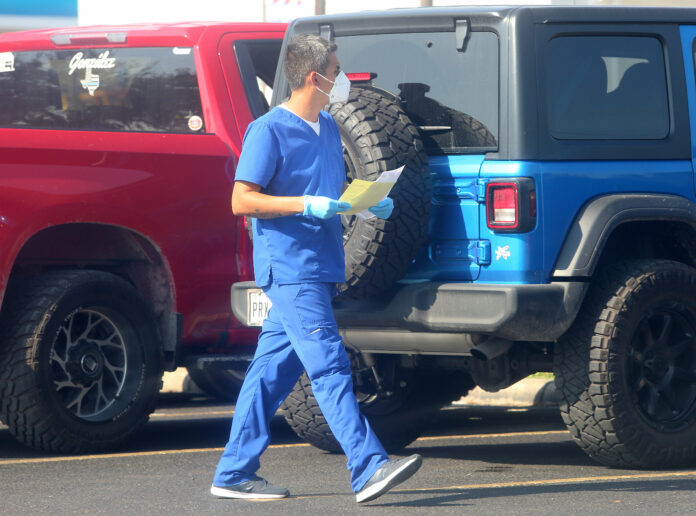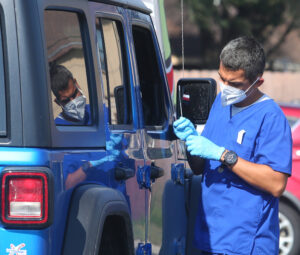
In the face of increasing hospitalizations and spread of the omicron variant, Hidalgo County’s lead physician is advising the county to disregard new recommendations issued by the Centers for Disease Control and Prevention which shorten the length of isolation for those who test positive for COVID-19.

Dr. Ivan Melendez, the Hidalgo County health authority, said he advised the county commissioners court on Tuesday to continue asking the public to isolate for 10 days if they test positive for COVID-19.
His own recommendation comes a day after the CDC issued guidelines which Melendez called “unacceptable.” It also comes as long lines begin to form at COVID-19 testing centers across the Rio Grande Valley and hospitalizations in Hidalgo County increase by about 25%.
In a statement Monday, the CDC said that based on what they knew of the omicron variant, they were shortening the recommended time for isolation from 10 days to five for people with COVID-19 if they were asymptomatic, followed by five days of wearing a mask when around others.
“The change is motivated by science demonstrating that the majority of SARS-CoV-2 transmission occurs early in the course of illness, generally in the 1-2 days prior to onset of symptoms and the 2-3 days after,” the CDC said in its statement.
But Melendez suspected the CDC changed their recommendations in response to staffing shortages at hospitals.
“Up until now, if you were infected, the recommendation was always 10 days at home, 10 days quarantine,” Melendez said. “They decided that it was going to be 10 days for everyone and then five days for health care workers. We suspect that it was because there’s such a short availability for health care workers and there was a great response saying ‘wait a minute, it’s got to be the same rules for everyone.’
“And so they came out saying that ‘no, it’s going to be, instead of 10 days isolation, it’s five days isolation if you test positive,'” he said.
But because of increasing hospitalizations, the return to in-person classes in a few days, and the higher rate of infection with omicron, Melendez said he recommended to the commissioners court that the county maintain guidelines that include a 10-day isolation period.
“In countries where it started, including our own, we’re seeing a doubling every two days. Every two days, the cases double — that’s never been seen before so we know that this particular mutation is much easier to spread the infection than the other ones,” Melendez said. “In the northeast where omicron landed on December 5, they’re seeing a four-fold increase in pediatric admissions and we’re always about two or three weeks behind what’s happening in the northeast because that’s how long it takes for it to come over here.”
He added that there was about a 20-25% increase in hospitalizations in our community since Dec. 5.

On Dec. 6, Hidalgo County reported 61 COVID-19 hospitalizations. On Tuesday, they were up to 79, a 29% increase.
Across the entire Rio Grande Valley, there were 97 COVID hospitalizations on Monday, according to data posted on Tuesday by the Texas Department of State Health Services, or DSHS.
That’s an increase of ten patients compared to the previous day, Dec. 26, when there were 87 total COVID hospitalizations in the Valley. The day before that, Dec. 25, there were 79 hospitalizations.
Melendez also pointed out that hospitals were cutting back on visitations and that the city of Pharr had canceled its New Year’s Eve ball drop event due to the spread of the omicron variant.
“Everywhere that you look, whether it’s in incidents, hospitalizations, community restrictions, etc., etc., why in the world would we want to be less restrictive?” Melendez asked.
In addition to their hospitalizations, Hidalgo County reported 67 new COVID cases on Tuesday, though no new deaths.
The new cases included 39 confirmed cases and 28 probable cases. The COVID death toll for the county remained at 3,525.
Cameron County health officials reported 62 new confirmed cases but also reported zero deaths on Tuesday. The county now has a total number of 54,641 confirmed cases while their COVID death toll remained at 2,028.
Starr County reported four new confirmed cases and six probable cases on Tuesday, while Willacy County reported two new confirmed cases, according to DSHS data.
Melendez believes that the hospitalizations and COVID deaths are still caused by the Delta variant, but that most of the new cases in the community are of the omicron variant.
“I believe that with the passage of time, the natural evolution of the virus, you’ll start seeing more and more omicron emissions in the hospital,” he said.
Unfortunately, he added, local health officials don’t have the tools to segment the population, which means to test a portion of the population for the variant.
“Ideally you would want to test 10% of all people that tested positive,” he said. “You want to segment the virus so you can see which particular virus it is.”
But the United States currently segments about 4% of the people that test positive. In Texas, it’s less than 1%.
“In the Valley, I bet even less,” Melendez said. “So we’re doing less than 1% testing or segmenting, so we don’t know. That’s why we haven’t had a positive, because we’re not testing.”
His advice for the county would be to wait to see where the local COVID-19 statistics are in two weeks, adding that he also favors keeping mask mandates for schools until they have a better picture of the omicron situation.
“And then if we think that it’s time to be less restrictive, absolutely,” Melendez said. “But I don’t believe this is the time to be less restrictive.”




